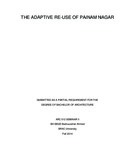The adaptive re-use of Painam nagar

View/Open
Date
2014Publisher
BRAC UniversityAuthor
Ahmed, BadruzzahanMetadata
Show full item recordAbstract
Painam Nagar is a set of fifty-two abandoned street-front houses once owned by rich Hindu merchant families. It is situated in Sonargaon, the ancient capital of Bengal during the Sultanate Period, at present day 17 miles east of Dhaka. Painam Nagar flourished in the late 19th and early 20th Century as it grew as a by-product of the trading and commercial activities of the British rulers. Most of the surviving houses were built during this period, but many hold evidence to have been built during the Mughal rule. However, today this strip of street is abandoned and deserted, much like a ghost town, yet somehow still flamboyantly expressing its grandeur and ambience of what it
must have been in its hey-day. Even though the buildings are engulfed by vegetation and many crumpling away with time, one walk down the Painam Street is still capable of transporting its visitors back in time. Today Painam Nagar stands as an idle asset. The site's convenient location amidst many historically important sites and other recreational facilities only adds to its potential. Painam Nagar is an ideal candidate for conservation, preservation or adaptive re-use. This site is important by all accounts; historically, culturally and architecturally. However, it remains rather isolated from its
surroundings. But it cannot be denied that the socio-cultural scene of Bangladesh today is as much a part of Painam Nagar, as is its history. This paper discusses the approach chosen along with the justifications, for the conservation and management of Painam Nagar, all with the intention that Painam Nagar will continue to exist with the respect it deserves.
